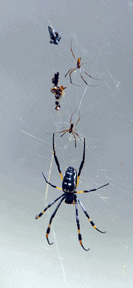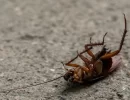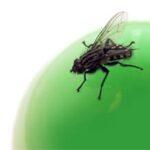Crawling insects, such as spiders, fleas, ants, and cockroaches, can make your life miserable. They invade your space and, in some cases, can be dangerous to your health. Fortunately, however, there are a variety of ways to deal with these little creatures. Here we begin with a discussion of spiders. For other crawling insects, please see the links above right.
Controlling Spiders
Spiders are found virtually everywhere, from mountaintops to the seashore. They are commonly associated with water, soil, leaf litter, and low, dense plant growth. But only a few of the over 2,500 U.S. species may be found in human habitations.
Spiders, like insects, belong to a larger group of animals known as arthropods. Spiders differ from insects in several ways. As a group, spiders are recognized by their two-segmented bodies (cephalothorax and abdomen), eight legs (insects have six), and four to eight simple eyes. In addition, spiders lack wings and antennae. Hence, spiders are more closely related to ticks, mites, daddy longlegs, and scorpions than to insects.
A key attribute of spiders is their production and use of silk, which is produced by special glands located near the tip of the abdomen. It is secreted as a liquid, which hardens when exposed to the air. Spiders use the silk to capture prey in webs and traps, build shelters, wrap egg sacks, and for locomotion (draglines and parachutes).
Spiders hatch from eggs bundled together in sacs. The female may carry the sac with her or tuck it away in a secluded spot. Young spiders (called spiderlings) are miniature replicas of adult spiders, and they grow through a series of molts. Most spiders live for one to two years. Since spiders are cold-blooded invertebrates, their activity is greatly reduced or even curtailed by cold temperatures.
Spiders are largely beneficial to man. They are predaceous and feed on a variety of live prey including insects, centipedes, and even other spiders. In fact, in many habitats, spiders are the dominant group of predators and frequently outnumber all other predators combined. While some spiders use webs or traps to capture their prey, others actively stalk or ambush their prey.
Spiders lack jaws for chewing. Instead, they have fang-like pincers and special poison glands. This poison is used to subdue the prey by injecting it through the hollow fangs. Then, a unique enzymatic saliva is used to predigest the muscle and internal viscera of the prey so that it can then be sucked up by the spider.
The danger of spider bites has for the most part been greatly exaggerated. Most spiders are not dangerous to man under normal conditions, and only a few species are of public health significance. Most spiders will not bite unless provoked or threatened, and even then only the larger species are capable of piercing human skin with their fangs.
In addition, the vast majority of spiders have secretive habits, so they are seldom encountered by man. Representatives of five families of spiders are commonly encountered in and around the home. They are briefly described below:
Cobweb spiders
One of the most common groups of indoor spiders, they are small (less than 1/2 inch in length) and are pale yellow, tan, or gray without any distinct markings. They build irregular webs in corners and around windows and curtains. The webs remain inconspicuous until they are abandoned and become dust-covered.
Yellow house spiders
These usually are found outdoors among the leaves of shrubs and other small plants, but they also build their webs inside houses from time to time. They have been reported to bite with painful consequences and some necrosis.
Wolf spiders
Large, hairy, active spiders that normally are found outdoors, they do not build webs; instead, they wander about in search of prey. As a result, they may find their way into houses, especially basements. They can and will bite if threatened.
Jumping spiders
Medium-sized, black, and hairy (often with spots of orange or red on the abdomen), when found indoors they are usually around windows and doors and they move about with characteristic short, sudden jumps.
Orb weavers
These very large, conspicuous spiders construct large orb-like webs for snaring their prey. These webs are usually constructed in open areas near gardens and houses where flying insects will blunder into the webs. Despite their large size, these spiders are not dangerous.
The first consideration in spider control is to determine whether or not the spiders are likely to live indoors. If large numbers of spiders are seen indoors, they could be more of a problem than a nuisance, as when found outdoors.
Most “domestic” spiders are small in size (1/4 inch), uniformly colored (pale yellow, tan, or gray), and not hairy. Those spiders that are casual invaders and would normally reside outdoors are larger (1/2 inch), hairy, distinctly patterned (even brightly colored), and usually jump or run quickly.
General sanitation, both indoors and outdoors, is very important in spider control. Clean up all woodpiles, rocks, trash, compost piles, old boards, and other debris. Exercise caution when working around any materials that have been stockpiled for any length of time.
All garages, cellars, crawlspaces, and such must be kept clean and uncluttered. Control of excess moisture is also helpful. Keep crawlspaces, basements, and porches as dry as possible. Plant trees and shrubs far enough away from the foundation to allow sunlight and wind to penetrate.
Those spiders that enter buildings from outdoors usualy do so through small cracks and crevices. Thus, the sealing or caulking of these entrances will aid in spider control. Screens, and tight-fitting doors and windows will also help keep spiders out.
Indoors, move and dust frequently behind and under furniture, stored materials, and wall hangings. Do not allow objects to remain in one place too long. Also, since spiders are strictly carnivorous, the elimination of household insects such as cockroaches, bedbugs, ants, and other prey will help discourage spider infestations.
The best mechanical control device is the vacuum. Vacuum corners, registers, and window angles often. If you choose to use an insecticide out of doors, apply diazinon 25% EC around foundation walls and the adjacent 1 foot of soil. Indoors, ready-to-use formulations of chlorpyrifos and propoxur are suggested. Use proper precautions and follow the label instructions precisely. Do not use diazinon indoors.
Courtesy MSU Extension
Revised by Tom Ellis, M.S., Department of Entomology








 Don Vandervort writes or edits every article at HomeTips. Don has:
Don Vandervort writes or edits every article at HomeTips. Don has:
